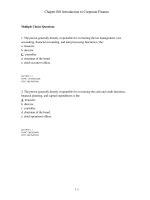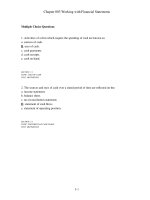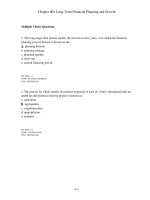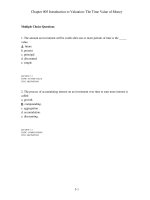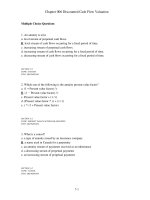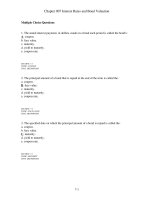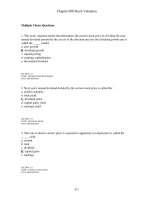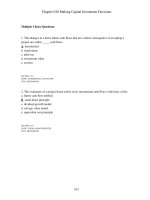Test bank corporate finance 8e ros chap005
Bạn đang xem bản rút gọn của tài liệu. Xem và tải ngay bản đầy đủ của tài liệu tại đây (223.64 KB, 28 trang )
Chapter 005 Introduction to Valuation: The Time Value of Money
Multiple Choice Questions
1. The amount an investment will be worth after one or more periods of time is the _____
value.
A. future
b. present
c. principal
d. discounted
e. simple
SECTION: 5.1
TOPIC: FUTURE VALUE
TYPE: DEFINITIONS
2. The process of accumulating interest on an investment over time to earn more interest is
called:
a. growth.
B. compounding.
c. aggregation.
d. accumulation.
e. discounting.
SECTION: 5.1
TOPIC: COMPOUNDING
TYPE: DEFINITIONS
3. Interest earned on the reinvestment of previous interest payments is called _____ interest.
a. free
b. annual
c. simple
D. interest on
e. compound
SECTION: 5.1
TOPIC: INTEREST ON INTEREST
TYPE: DEFINITIONS
5-1
Chapter 005 Introduction to Valuation: The Time Value of Money
4. Interest earned on both the initial principal and the interest reinvested from prior periods is
called _____ interest.
a. free
b. annual
c. simple
d. interest on
E. compound
SECTION: 5.1
TOPIC: COMPOUND INTEREST
TYPE: DEFINITIONS
5. Interest earned only on the original principal amount invested is called _____ interest.
a. free
b. annual
C. simple
d. interest on
e. compound
SECTION: 5.1
TOPIC: SIMPLE INTEREST
TYPE: DEFINITIONS
6. The future value interest factor is computed as:
A. (1 + r)t.
b. (1 + rt).
c. (1 + r) t.
d. 1 + r t.
e. (1+ r) rt.
SECTION: 5.1
TOPIC: FUTURE VALUE INTEREST FACTOR
TYPE: DEFINITIONS
5-2
Chapter 005 Introduction to Valuation: The Time Value of Money
7. The value today of future cash flows discounted at the appropriate discount rate is called
the _____ value.
a. principal
b. future
C. present
d. simple
e. compound
SECTION: 5.2
TOPIC: PRESENT VALUE
TYPE: DEFINITIONS
8. The process of finding the present value of some future amount is commonly called:
a. growth.
B. discounting.
c. accumulation.
d. compounding.
e. reduction.
SECTION: 5.2
TOPIC: DISCOUNTING
TYPE: DEFINITIONS
9. The present value interest factor is computed as:
a. 1 / (1 + r t).
b. 1 / (1 + rt).
c. 1 / (1 + r) t.
D. 1 / (1 + r)t.
e. 1 + r + t.
SECTION: 5.2
TOPIC: PRESENT VALUE INTEREST FACTOR
TYPE: DEFINITIONS
5-3
Chapter 005 Introduction to Valuation: The Time Value of Money
10. The interest rate used to calculate the present value of future cash flows is called the
_____ rate.
a. free
b. annual
c. compound
d. simple
E. discount
SECTION: 5.2
TOPIC: DISCOUNT RATE
TYPE: DEFINITIONS
11. As the discount rate increases, the present value of $2,000 to be received four years from
now:
a. remains constant.
b. also increases.
C. decreases.
d. becomes negative.
e. will vary but the direction of the change is unknown.
SECTION: 5.2
TOPIC: PRESENT VALUE AND DISCOUNT RATE
TYPE: CONCEPTS
12. Jeff is going to receive $10,000 five years from now. Tammy is going to receive $10,000
eight years from now. Which one of the following statements is correct if both Tammy and
Jeff apply a 6 percent discount rate to these amounts?
a. The present value of Tammy's and Jeff's money will be equal.
b. The value of Jeff's money will be less than the value of Tammy's money 15 years from
now.
C. In today's dollars, Jeff's money is worth more than Tammy's.
d. Ten years from now, the value of Jeff's money will be equal to the value of Tammy's
money.
e. Tammy's money is worth more than Jeff's money given the 6 percent discount rate.
SECTION: 5.2
TOPIC: PRESENT VALUE AND TIME
TYPE: CONCEPTS
5-4
Chapter 005 Introduction to Valuation: The Time Value of Money
13. Tracie deposits $5,000 into an account that pays 3 percent interest compounded annually.
Chris deposits $5,000 into an account that pays 3 percent simple interest. Both deposits were
made this morning. Which of the following statements are true concerning these two
accounts?
I. At the end of one year, both Tracie and Chris will have the same amount in their accounts.
II. At the end of five years, Tracie will have more money in her account than Chris has in his.
III. Chris will never earn any interest on interest.
IV. All else equal, Chris made the better investment.
a. I and II only
b. III and IV only
C. I, II, and III only
d. I, III, and IV only
e. II, III, and IV only
SECTION: 5.1
TOPIC: SIMPLE VERSUS COMPOUND INTEREST
TYPE: CONCEPTS
14. Kate invests $3,000 at 9 percent when she is 20 years old. Kurt invests $3,000 at 9 percent
when he is 35 years old. Both investments compound interest annually. Both Kate and Kurt
retire at age 60. Which one of the following statements is correct?
a. Kate will have less money when she retires than Kurt.
b. Kurt will earn more interest on interest than Kate.
c. Kurt will earn more compound interest than Kate.
d. If Kurt waits to age 70 to retire, then he will have just as much money as Kate.
E. Kate will have more money when she retires than Kurt.
SECTION: 5.1
TOPIC: FUTURE VALUE AND TIME
TYPE: CONCEPTS
5-5
Chapter 005 Introduction to Valuation: The Time Value of Money
15. Raoul has $800 today. Which one of the following statements is correct if he invests this
money at a positive rate of interest for ten years? Assume the interest is compounded
annually.
a. The higher the interest rate he earns, the less money he will have in the future.
b. The higher the interest rate, the longer he has to wait for his money to grow to $2,000 in
value.
c. If Raoul can earn 7 percent, he will have to wait about six years to have $1,600 total.
d. At the end of the ten years, Raoul will have less money if he invests at 9 percent rather than
at 8 percent.
E. At 7.2 percent interest, Raoul should expect to have about $1,600 in his account at the end
of the ten years.
SECTION: 5.1
TOPIC: RULE OF 72
TYPE: CONCEPTS
16. Frank invests $2,500 in an account that pays 6 percent simple interest. How much money
will he have at the end of four years?
a. $2,650
B. $3,100
c. $3,156
d. $3,163
e. $10,600
Ending value = $2,500 + ($2,500
.06
4) = $3,100.00
AACSB TOPIC: ANALYTIC
SECTION: 5.1
TOPIC: SIMPLE INTEREST
TYPE: PROBLEMS
5-6
Chapter 005 Introduction to Valuation: The Time Value of Money
17. Faith invests $4,500 in an account that pays 4 percent simple interest. How much money
will she have at the end of eight years?
a. $4,680
b. $5,367
C. $5,940
d. $6,122
e. $6,159
Ending value = $4,500 + ($4,500
.04
8) = $5,940.00
AACSB TOPIC: ANALYTIC
SECTION: 5.1
TOPIC: SIMPLE INTEREST
TYPE: PROBLEMS
18. Jessica invests $3,000 in an account that pays 5 percent simple interest. How much more
could she have earned over a 7-year period if the interest had compounded annually?
a. $122.20
b. $129.20
c. $147.80
D. $171.30
e. $221.30
Ending value at 5 percent simple interest = $3,000 + ($3,000 .05 7) = $4,050.00;
Ending value at 5 percent compounded annually = $3,000 (1 + .05)7 = $4,221.30;
Difference = $4,221.30 $4,050.00 = $171.30
AACSB TOPIC: ANALYTIC
SECTION: 5.1
TOPIC: SIMPLE VERSUS COMPOUND INTEREST
TYPE: PROBLEMS
5-7
Chapter 005 Introduction to Valuation: The Time Value of Money
19. Jeff invests $3,000 in an account that pays 7 percent simple interest. How much more
could he have earned over a 20-year period if the interest had compounded annually?
a. $2,840.00
b. $3,212.12
c. $3,778.54
d. $4,087.18
E. $4,409.05
Ending value at 7 percent simple interest = $3,000 + ($3,000 .07 20) = $7,200.00;
Ending value at 7 percent compounded annually = $3,000 (1 + .07)20 = $11,609.05;
Difference = $11,609.05 $7,200.00 = $4,409.05
AACSB TOPIC: ANALYTIC
SECTION: 5.1
TOPIC: SIMPLE VERSUS COMPOUND INTEREST
TYPE: PROBLEMS
20. What is the future value of $3,497 invested for 15 years at 7.5 percent compounded
annually?
a. $7,431.13
B. $10,347.19
c. $14,289.16
d. $14,911.08
e. $15,267.21
Future value = $3,497
(1 + .075)15 = $10,347.19
AACSB TOPIC: ANALYTIC
SECTION: 5.1
TOPIC: FUTURE VALUE
TYPE: PROBLEMS
5-8
Chapter 005 Introduction to Valuation: The Time Value of Money
21. Today, you earn a salary of $42,500. What will be your annual salary 10 years from now
if you earn annual raises of 3.2 percent?
a. $56,100.00
b. $57,414.06
C. $58,235.24
d. $59,122.08
e. $59,360.45
Future value = $42,500
(1 + .032)10 = $58,235.24
AACSB TOPIC: ANALYTIC
SECTION: 5.1
TOPIC: FUTURE VALUE
TYPE: PROBLEMS
22. You own a classic automobile that is currently valued at $67,900. If the value increases by
8 percent annually, how much will the automobile be worth 15 years from now?
a. $199,801.33
b. $212,524.67
c. $214,740.01
D. $215,390.28
e. $218,887.79
Future value = $67,900
(1 + .08)15 = $215,390.28
AACSB TOPIC: ANALYTIC
SECTION: 5.1
TOPIC: FUTURE VALUE
TYPE: PROBLEMS
5-9
Chapter 005 Introduction to Valuation: The Time Value of Money
23. You hope to buy your dream house 3 years from now. Today, your dream house costs
$247,900. You expect housing prices to rise by an average of 7.5 percent per year over the
next 3 years. How much will your dream house cost by the time you are ready to buy it?
a. $292,063.48
b. $294,882.01
c. $298,600.00
D. $307,965.40
e. $309,425.45
Future value = $247,900
(1 + .075)3 = $307,965.40
AACSB TOPIC: ANALYTIC
SECTION: 5.1
TOPIC: FUTURE VALUE
TYPE: PROBLEMS
24. Your grandmother invested one lump sum 42 years ago at 3.5 percent interest. Today, she
gave you the proceeds of that investment which totaled $28,204.37. How much did your
grandmother originally invest?
a. $4,500
B. $6,650
c. $7,200
d. $7,500
e. $9,000
Present value = $28,204.37
[1 / (1 + .035)42] = $6,650.00
AACSB TOPIC: ANALYTIC
SECTION: 5.2
TOPIC: PRESENT VALUE
TYPE: PROBLEMS
5-10
Chapter 005 Introduction to Valuation: The Time Value of Money
25. What is the present value of $36,800 to be received 6 years from today if the discount rate
is 12 percent?
A. $18,644.03
b. $19,407.18
c. $19,414.14
d. $20,211.08
e. $20,390.14
Present value = $36,800
[1 / (1 + .12)6] = $18,644.03
AACSB TOPIC: ANALYTIC
SECTION: 5.2
TOPIC: PRESENT VALUE
TYPE: PROBLEMS
26. You would like to give your daughter $50,000 towards her college education 15 years
from now. How much money must you set aside today for this purpose if you can earn 9
percent on your investments?
a. $12,250.00
b. $12,989.47
C. $13,726.90
d. $14,008.50
e. $14,211.11
Present value = $50,000
[1 / (1 + .09)15] = $13,726.90
AACSB TOPIC: ANALYTIC
SECTION: 5.2
TOPIC: PRESENT VALUE
TYPE: PROBLEMS
5-11
Chapter 005 Introduction to Valuation: The Time Value of Money
27. One year ago, you invested $2,500. Today it is worth $2,789.50. What rate of interest did
you earn?
a. 8.67 percent
b. 9.89 percent
c. 10.67 percent
d. 11.42 percent
E. 11.58 percent
$2,789.50 = $2,500
(1 + r)1; r = 11.58 percent
AACSB TOPIC: ANALYTIC
SECTION: 5.3
TOPIC: INTEREST RATE FOR A SINGLE PERIOD
TYPE: PROBLEMS
28. Thirty years ago, your father invested $11,000. Today, that investment is worth $287,047.
What is the average annual rate of return your father earned on his investment?
a. 11.14 percent
b. 11.27 percent
c. 11.38 percent
D. 11.49 percent
e. 12.07 percent
$287,047 = $11,000
(1 + r)30; r = 11.49 percent
AACSB TOPIC: ANALYTIC
SECTION: 5.3
TOPIC: INTEREST RATE FOR MULTIPLE PERIODS
TYPE: PROBLEMS
5-12
Chapter 005 Introduction to Valuation: The Time Value of Money
29. Twelve years ago, Jake invested $2,000. Six years ago, Tami invested $4,000. Today,
both Jake's and Tami's investments are each worth $9,700. Assume that both Jake and Tami
continue to earn their respective rates of return. Which one of the following statements is
correct concerning these investments?
a. Three years from today, Jake's investment will be worth more than Tami's.
b. One year ago, Tami's investment was worth more than Jake's.
c. Jake has earned a higher rate of return than Tami.
D. Tami has earned an average annual interest rate of 15.91 percent.
e. Jake has earned an average annual interest rate of 15.47 percent.
Jake $9,700 = $2,000 (1 + r)12; r = 14.06 percent; Tami: $9,700 = $4,000 (1 + r)6; r =
15.91 percent; The correct answer states that Tami earned 15.91 percent interest.
AACSB TOPIC: ANALYTIC
SECTION: 5.3
TOPIC: INTEREST RATE FOR MULTIPLE PERIODS
TYPE: PROBLEMS
5-13
Chapter 005 Introduction to Valuation: The Time Value of Money
30. Tropical Tans is saving money to build a new salon. Three years ago, they set aside
$12,000 for this purpose. Today, that account is worth $16,418. What rate of interest is
Tropical Tans earning on this money?
a. 10.88 percent
b. 10.97 percent
C. 11.01 percent
d. 11.14 percent
e. 11.23 percent
$16,418 = $12,000
(1 + r)3; r = 11.01 percent
AACSB TOPIC: ANALYTIC
SECTION: 5.3
TOPIC: INTEREST RATE FOR MULTIPLE PERIODS
TYPE: PROBLEMS
31. Five years ago, Precision Tool set aside $50,000 in case of a financial emergency. Today,
that account has increased in value to $64,397. What rate of interest is the firm earning on this
money?
A. 5.19 percent
b. 5.47 percent
c. 6.18 percent
d. 6.32 percent
e. 6.45 percent
$64,397 = $50,000
(1 + r)5; r = 5.19 percent
AACSB TOPIC: ANALYTIC
SECTION: 5.3
TOPIC: INTEREST RATE FOR MULTIPLE PERIODS
TYPE: PROBLEMS
5-14
Chapter 005 Introduction to Valuation: The Time Value of Money
32. Six years ago, Home Health Industries (HHI) adopted a plan to expand its services next
year. At the time the plan was adopted, HHI set aside $125,000 in excess funds to be held for
this purpose. As of today, that money has increased in value to $186,408. What rate of interest
is the firm earning on these funds?
A. 6.89 percent
b. 7.10 percent
c. 7.18 percent
d. 7.27 percent
e. 7.43 percent
$186,408 = $125,000
(1 + r)6; r = 6.89 percent
AACSB TOPIC: ANALYTIC
SECTION: 5.3
TOPIC: INTEREST RATE FOR MULTIPLE PERIODS
TYPE: PROBLEMS
33. Some time ago, Richard purchased five acres of land costing $123,400. Today, that land is
valued at $189,700. How long has he owned this land if the price of land has been increasing
at 5.5 percent per year?
a. 6.01 years
b. 6.98 years
c. 7.42 years
D. 8.03 years
e. 8.67 years
$189,700 = $123,400
(1 + .055)t; t = 8.03 years
AACSB TOPIC: ANALYTIC
SECTION: 5.3
TOPIC: NUMBER OF TIME PERIODS
TYPE: PROBLEMS
5-15
Chapter 005 Introduction to Valuation: The Time Value of Money
34. On your thirteenth birthday, you received $1,000 which you invested at 6.5 percent
interest, compounded annually. Your investment is now worth $5,476. How old are you
today?
a. age 29
b. age 32
c. age 35
d. age 37
E. age 40
$5,476 = $1,000
(1 + .065)t; t = 27 years; Age today = 13 + 27 = 40
Note: You received the money when you were 13 years old. Thus, you will be 40 (13 + 27)
years old when the value reaches $5,476.
AACSB TOPIC: ANALYTIC
SECTION: 5.3
TOPIC: NUMBER OF TIME PERIODS
TYPE: PROBLEMS
5-16
Chapter 005 Introduction to Valuation: The Time Value of Money
35. You want to have $260,000 saved 15 years from now. How much less do you have to
deposit today to reach this goal if you can earn 8 percent rather than 7 percent on your
savings?
a. $8,728.44
B. $12,273.13
c. $16,602.12
d. $17,414.41
e. $20,019.27
Present value = $260,000 [1 / (1 + .08)15] = $81,962.84; Present value = $260,000
+ .07)15] = $94,235.97; Difference = $94,235.97 $81,962.84 = $12,273.13
AACSB TOPIC: ANALYTIC
SECTION: 5.2 AND 5.3
TOPIC: PRESENT VALUE AND RATE CHANGES
TYPE: PROBLEMS
5-17
[1 / (1
Chapter 005 Introduction to Valuation: The Time Value of Money
36. Your big brother deposited $10,000 today at 9 percent interest for 6 years. You would like
to have just as much money at the end of the next 6 years as your brother. However, you can
only earn 7.5 percent interest. How much more money must you deposit today than your
brother did if you are to have the same amount at the end of the 6 years?
a. $398.68
b. $487.63
c. $575.00
d. $648.21
E. $866.96
Future value = $10,000 (1 + .09)6 = $16,771.00; Present value = $16,771.00
075)6] = $10,866.96; Difference = $10,866.96 $10,000.00 = $866.96
AACSB TOPIC: ANALYTIC
SECTION: 5.2 AND 5.3
TOPIC: PRESENT VALUE AND RATE CHANGES
TYPE: PROBLEMS
5-18
[1 / (1 + .
Chapter 005 Introduction to Valuation: The Time Value of Money
37. Last year, you deposited $25,000 into a retirement savings account at a fixed rate of 7.5
percent. Today, you could earn a fixed rate of 8 percent on a similar type account. However,
your rate is fixed and cannot be adjusted. How much less could you have deposited last year if
you could have earned a fixed rate of 8 percent and still have the same amount as you
currently will when you retire 40 years from today?
a. $1,218.46 less
b. $1,666.67 less
c. $2,408.28 less
d. $3,628.09 less
E. $4,331.30 less
Future value = $25,000 (1 + .075)41 = $484,938.92; Present value = $484,938.92
+ .08)41] = $20,668.70; Difference = $25,000.00 $20,668.70 = $4,331.30
AACSB TOPIC: ANALYTIC
SECTION: 5.2 AND 5.3
TOPIC: PRESENT VALUE AND TIME CHANGES
TYPE: PROBLEMS
5-19
[1
(1
Chapter 005 Introduction to Valuation: The Time Value of Money
38. When you retire 36 years from now, you want to have $2 million. You think you can earn
an average of 11.5 percent on your investments. To meet your goal, you are trying to decide
whether to deposit a lump sum today, or to wait and deposit a lump sum 3 years from today.
How much more will you have to deposit as a lump sum if you wait for 3 years before making
the deposit?
A. $15,344.14
b. $15,677.78
c. $16,208.11
d. $17,021.12
e. $19,407.78
Present value = $2,000,000 [1 / (1 + .115)36] = $39,731.48; Present value = $2,000,000
/ (1 + .115)33] = $55,075.62; Difference = $55,075.62 $39,731.48 = $15,344.14
AACSB TOPIC: ANALYTIC
SECTION: 5.2 AND 5.3
TOPIC: PRESENT VALUE AND RATE CHANGES
TYPE: PROBLEMS
5-20
[1
Chapter 005 Introduction to Valuation: The Time Value of Money
39. Marie needs $26,000 as a down payment for a house 4 years from now. She earns 5.25
percent on her savings. Marie can either deposit one lump sum today for this purpose or she
can wait a year and deposit a lump sum. How much additional money must Marie deposit if
she waits for one year rather than making the deposit today?
a. $878.98
b. $911.13
C. $1,112.36
d. $1,348.03
e. $1,420.18
Present value = $26,000 [1 / (1 + .0525)4] = $21,187.75; Present value = $26,000
+ .0525)3] = $22,300.11; Difference = $22,300.11 $21,187.75 = $1,112.36
AACSB TOPIC: ANALYTIC
SECTION: 5.2 AND 5.3
TOPIC: PRESENT VALUE AND TIME CHANGES
TYPE: PROBLEMS
5-21
[1 / (1
Chapter 005 Introduction to Valuation: The Time Value of Money
40. Wexter and Daughter invested $165,000 to help fund a company expansion project
planned for 3 years from now. How much additional money will the firm have saved 3 years
from now if it can earn 7 percent rather than 5 percent on this money?
a. $7,940.09
b. $8,218.07
C. $11,123.97
d. $12,648.18
e. $13,211.21
Future value = $165,000 (1 + .07)3 = $202,132.10; Future value = $165,000
$191,008.13; Difference = $202,132.10 $191,008.13 = $11,123.97
AACSB TOPIC: ANALYTIC
SECTION: 5.1 AND 5.3
TOPIC: FUTURE VALUE AND RATE CHANGES
TYPE: PROBLEMS
5-22
(1 + .05)3 =
Chapter 005 Introduction to Valuation: The Time Value of Money
41. You just received $278,000 from an insurance settlement. You have decided to set this
money aside and invest it for your retirement. Currently, your goal is to retire 38 years from
today. How much more will you have in your account on the day you retire if you can earn an
average return of 9.5 percent rather than just 9.0 percent?
a. $794,014
B. $1,396,036
c. $1,611,408
d. $1,818,342
e. $2,033,333
Future value = $278,000 (1 + .095)38 = $8,745,433.15; Future value = $278,000
09)38 = $7,349,397.17; Difference = $8,745,433.15 $7,349,397.17 = $1,396,036
AACSB TOPIC: ANALYTIC
SECTION: 5.1 AND 5.3
TOPIC: FUTURE VALUE AND RATE CHANGES
TYPE: PROBLEMS
5-23
(1 + .
Chapter 005 Introduction to Valuation: The Time Value of Money
42. You will be receiving $2,500 from your family as a graduation present. You have decided
to save this money for your retirement. You plan to retire 40 years after graduation. How
much additional money will you have at that time if you can earn an average of 12.5 percent
on your investment instead of just 12 percent?
A. $45,370.08
b. $51,400.62
c. $53,018.97
d. $58,811.99
e. $64,367.48
Future value = $2,500 (1 + .125)40 = $277,997.51; Future value = $2,500
$232,627.43; Difference = $277,997.51 $232,627.43 = $45,370.08
AACSB TOPIC: ANALYTIC
SECTION: 5.1 AND 5.3
TOPIC: FUTURE VALUE AND RATE CHANGES
TYPE: PROBLEMS
5-24
(1 + .12)40 =
Chapter 005 Introduction to Valuation: The Time Value of Money
43. You deposit $1,000 in a retirement account today at 8.5 percent interest. How much more
money will you have if you leave the money invested for 40 years rather than 35 years?
a. $7,714.91
b. $7,799.08
c. $7,839.73
d. $7,846.52
E. $8,753.38
Future value = $1,000 (1 + .085)40 = $26,133.02; Future value = $1,000
$17,379.64; Difference = $26,133.02 $17,379.64 = $8,753.38
AACSB TOPIC: ANALYTIC
SECTION: 5.1 AND 5.3
TOPIC: FUTURE VALUE AND TIME CHANGES
TYPE: PROBLEMS
5-25
(1 + .085)35 =
